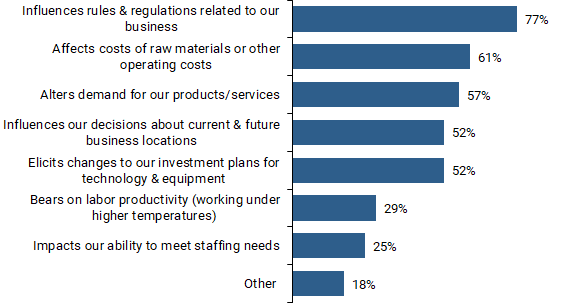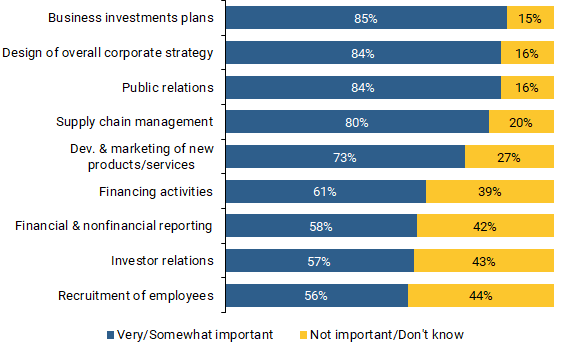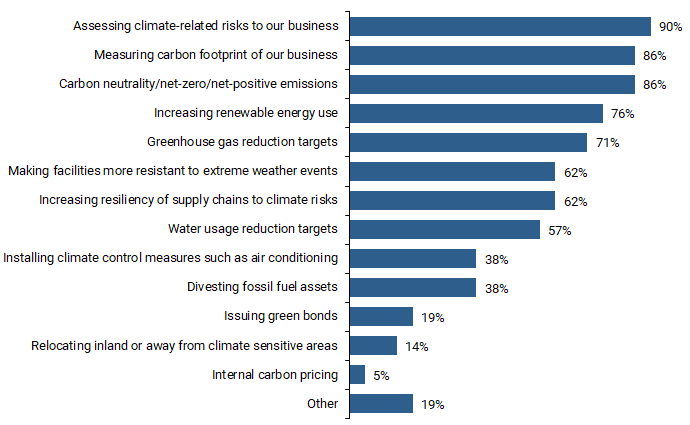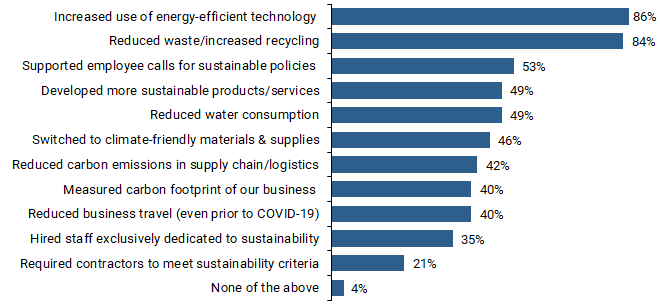Understanding what kinds of climate-related risks businesses could face is part of the Federal Reserve’s work to support a thriving economy and well-functioning financial system. To advance these goals, the San Francisco Fed surveyed businesses in its nine-state region to learn how they perceive and approach climate risk. Findings show that businesses view a changing climate as a moderate risk to their activities, particularly through possible regulation changes, higher input costs, and variations in demand. Many businesses are adopting formal risk mitigation strategies, including monitoring climate-risk exposure and reducing carbon dependence.
Climate change is a major transition that our society is facing, with ultimate effects that depend on group actions taken by government, businesses, and communities around the world. In this context, Federal Reserve officials have argued that a clear understanding of climate risk is imperative for the Fed to help promote a thriving economy with low inflation, maximum employment, and a well-functioning financial system (Brainard 2021, Daly 2021, and Stiroh 2019).
With these goals in mind, the San Francisco Fed launched its first business survey focused on climate risk, seeking input from nearly 100 businesses within the 12th Federal Reserve District, a diverse and large area encompassing the states of Alaska, Arizona, California, Hawaii, Idaho, Nevada, Oregon, Utah, and Washington, as well as U.S. territories in the Pacific. Conducted in the fall of 2021, this survey seeks to better understand how businesses across a wide range of industries are perceiving and adapting to climate risk (see extended report here).
In this Economic Letter, we summarize the survey’s main findings. Overall, businesses in the District are moderately concerned by climate risk, particularly the impact of anticipated changes in regulations, higher input costs, and variations in demand. While a number of firms find it more practical to informally consider climate risk in their everyday decisionmaking process, others have adopted formal risk mitigation strategies, particularly those in the agricultural and resource-related sector. Although approaches to climate-related risk varied substantially across the District and sectors of business activity, some of the emerging themes included risk monitoring, reduction of carbon dependence, and an emphasis on social responsibility.
A moderate risk for most firms
Survey results showed that climate risk is a moderate concern for most businesses in the District. If climate risk is not already having an impact on their activities, firms expect that it will affect their revenue, costs, or investments in the future. Sixty percent of respondents confirmed that they are already feeling or expect to feel such effects to their bottom lines in the future. The vast majority of those who flagged climate risk as a concern recognized it as a high (29%) or a moderate priority (61%) issue. Respondents who assigned a lower priority to climate risk mentioned competing priorities, suggesting that limited resources may be preventing some firms from putting additional effort toward climate risk mitigation. Financial and COVID-related concerns were the two competing sources of risk cited most often.
The most common avenue through which climate risk has or is expected to have an impact on businesses is through influencing rules and regulations (Figure 1). Firms additionally recognized that climate risk may raise the cost of doing business through higher prices for raw materials and general operating costs and may also change the demand for their products and services. Additional considerations include the adoption of new technologies and the choice of different business locations to mitigate the impact of climate risk on their activities.
Figure 1
How does climate change affect or is expected to affect your business’s revenue, costs, and investments?

Note: Percentages refer to percent of respondents to this question.
Source: San Francisco Fed’s Survey on Climate Risk 2021.
Climate risk and everyday decisionmaking
Further details reveal that many firms often consider climate risk in their everyday business decisions. Most firms rated climate concerns as at least a somewhat important consideration across many facets of their decisionmaking, including for overall investment plans, corporate strategy, and public relations (Figure 2).
Figure 2
In which of the following decisionmaking areas is climate risk an important consideration for your business?

Note: Percentages refer to percent of respondents to this question.
Source: San Francisco Fed’s Survey on Climate Risk 2021.
For many firms, measures to address climate risk are already well integrated in their overall corporate strategy. For example, respondents highlighted that being a climate-conscious business has increasingly become a consideration for new hires and applicants, especially among younger workers. Climate-related capital investments have also received much attention, with some companies reportedly making substantial investments in purchasing wind and solar equipment, battery storage for renewable energy, electric vehicle (EV) charging stations, and new irrigation systems in the case of agricultural firms. In addition to physical investments, these new technologies also required them to install revamped software and IT systems to manage the more intermittent form of energy generation. Several respondents mentioned longer-term plans to fortify their buildings and retail spaces to protect against extreme weather events or to move away from rising sea levels. Finally, regardless of the expected higher costs, most firms have started diversifying their supply chains and assessing multiple vendors based on their environmental practices.
How businesses interact with the public also plays an important role in their responses to climate risk. Most firms reported that their top reasons to take climate-related action went beyond increased vulnerability to climate risk to include demand from consumers, changing requirements or regulations across government levels, and reputational risk. In terms of public relation strategies, firms found that direct communication from their executive leadership was the most effective way to communicate their climate plans to various stakeholders.
Formal risk mitigation strategies: More monitoring, less carbon dependence
Recognizing that climate change imposes risks to their bottom lines, some businesses have already formalized longer-term risk mitigation strategies. Over one-third of respondents that expect to be affected by climate change said that they have designed a formal risk mitigation plan for climate risk or are in the process of doing so. The agriculture and resource-related sector shows the highest concentration of firms that have developed a plan—about half of the firms within the sector that responded to the survey.
Existing formal risk mitigation strategies focus mostly on monitoring risks and reducing carbon dependence (Figure 3). Companies in industries that are particularly vulnerable to wildfire and droughts mentioned working with local governments and nonprofits in monitoring and assessing risks. Financial institutions mentioned using specialized tools to measure the impact of climate risk on their loan portfolios and real estate holdings, although the metrics and methodologies varied among different institutions. In addition, many companies reported measuring their carbon footprint annually.
Figure 3
Which of the following initiatives does your climate risk mitigation plan include?

Note: Percentages refer to percent of respondents to this question.
Source: San Francisco Fed’s Survey on Climate Risk 2021.
Many firms reported that a part of their formal climate risk mitigation strategy is to achieve carbon neutrality, which can also serve as a corporate social responsibility target (see next section). Although specific goals varied significantly by firm, several mentioned following the guidelines from the Task Force on Climate-Related Financial Disclosures, an initiative developed by the G20 Financial Stability Board (TCFD 2017). In general, companies are targeting either a notable reduction or net neutrality in carbon emissions by 2025 or 2030, with a few targeting 2040 or beyond. A few large tech companies and large banks mentioned having already achieved carbon neutrality.
Another significant portion of formal risk mitigation strategies includes using renewable energy sources and setting greenhouse gas emission targets. In addition to switching to solar and wind energy sources, some companies have increased their use of renewable energy by using renewable natural gas in transportation and investing in fuel cell and biomass technology, which uses salvage timber and other agricultural waste to produce energy. As for reducing greenhouse gas emissions, efforts have been especially focused on improving energy efficiency of equipment, supply chains, transportation, and buildings including through the deployment of EVs and carbon offsetting technologies.
Corporate social responsibility: Other sustainability considerations
While not all firms are adopting formal risk mitigation strategies, many have recognized that corporate social responsibility has played an important role in their increased focus on sustainability. Almost two-thirds of all respondents, including companies that have allocated a low priority to climate risk and/or do not have a formal plan, indicated that they have taken the initiative to implement additional sustainability measures purely in the interest of corporate social responsibility and environmental, social, and governance (ESG) initiatives—more than double the number of companies that have a formal risk mitigation plan. Nonetheless, specific measures can be difficult to categorize: what some firms report as being part of their formal risk mitigation strategies may be seen by others as stand-alone actions related to corporate social responsibility and ESG initiatives. Reported actions include using energy-efficient equipment, reducing waste and water consumption, supporting sustainable policies, and developing more sustainable products (Figure 4).
Figure 4
Has your business implemented any of the (additional) sustainability-related measures listed below?

Note: Percentages refer to percent of respondents to this question.
Source: San Francisco Fed’s Survey on Climate Risk 2021.
Overall, businesses overwhelmingly agreed that focusing on sustainability will be crucial going forward. Respondents recognized that climate risk and sustainability issues will require a long-term commitment to learning about this risk, implementing risk mitigation strategies, and assessing results. Firms also highlighted some ongoing concerns related, for instance, to the lack of reliable ESG measurement data to help make decisions in the real estate and finance sectors. Several respondents also mentioned that the increased incidence of extreme weather events has caused insurance costs to rise in many areas, leaving most of the burden on homeowners. A few manufacturing and utility companies that operate across several states highlighted that it is getting more challenging to meet different state requirements because the regulations sometimes evolve in conflicting directions.
Conclusion
Climate risk and sustainability issues are topics of moderate concern for most businesses surveyed in the 12th District. Many have integrated climate risk considerations in their everyday decisionmaking, while others have addressed their concerns by formally establishing climate risk mitigation strategies.
Overall, businesses are focused on climate risk monitoring and reducing carbon emissions in their operations. Business areas that have evolved the most in response to climate risk considerations include investment plans, corporate strategy setting, public relations, and corporate social responsibility. Still, businesses highlighted that they face important hurdles to appropriately address climate risk, including limited resources, a lack of proper measurement data, and rapidly changing regulations.
Hishgee Jargalsaikhan is an economic analyst in the Economic Research Department of the Federal Reserve Bank of San Francisco.
Sylvain Leduc is the director of the Economic Research Department of the Federal Reserve Bank of San Francisco.
Luiz E. Oliveira is a senior associate economist in the Economic Research Department of the Federal Reserve Bank of San Francisco.
References
Brainard, Lael. 2021. “Financial Stability Implications of Climate Change.” Speech at the “Transform Tomorrow Today” Ceres 2021 Conference, Boston, MA (via webcast), March 23.
Daly, Mary. 2021. “Climate Risk and the Fed: Preparing for an Uncertain Certainty.” Speech delivered at the Peterson Institute for International Economics, Washington DC.
Stiroh, Kevin J. 2019. “Emerging Issues for Risk Managers.” Remarks at the GARP Global Risk Forum, Federal Reserve Bank of New York, November 7.
Task Force on Climate-related Financial Disclosures (TCFD). 2017. “Recommendations of the Task Force on Climate-related Financial Disclosures,” June.
Opinions expressed in FRBSF Economic Letter do not necessarily reflect the views of the management of the Federal Reserve Bank of San Francisco or of the Board of Governors of the Federal Reserve System. This publication is edited by Anita Todd and Karen Barnes. Permission to reprint portions of articles or whole articles must be obtained in writing. Please send editorial comments and requests for reprint permission to research.library@sf.frb.org

